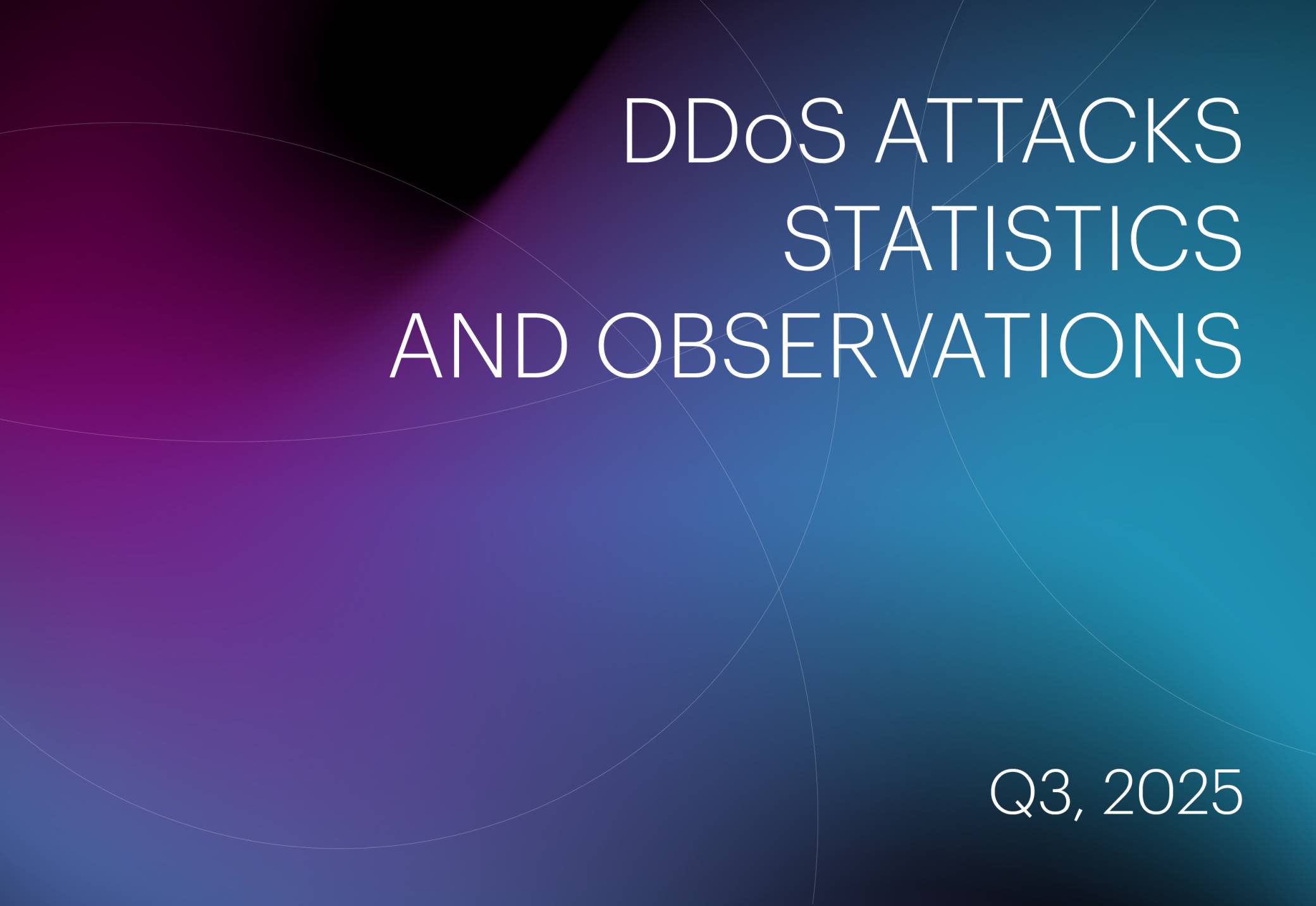
Starting from Q3 2025, we have updated our DDoS attack analysis methodology. Until now, we evaluated network- and transport-layer attacks (L3-L4 DDoS) separately from application-layer attacks (L7 DDoS). We are now using a unified approach that analyzes incidents, which may consist of multiple attacks across different vectors.
As before, we exclude L3-L4 DDoS attacks with an intensity below 1 Gbps, considering them background noise. For L7 DDoS attacks, we apply the following criteria: at least 100 blocked IP addresses and a rate of 1,000 requests per second or higher. Separate attack waves are grouped into a single incident if the time gap between them does not exceed one hour.
If we look at the pure DDoS attack vectors in Q3, the largest share was accounted for by HTTP — that is, application-layer attacks — which made up 73.9% of all recorded incidents. The second most common was UDP flood with a share of 12.3%, followed by IP flood with 7.9%. Notably, no ICMP flood attacks were recorded throughout Q3.
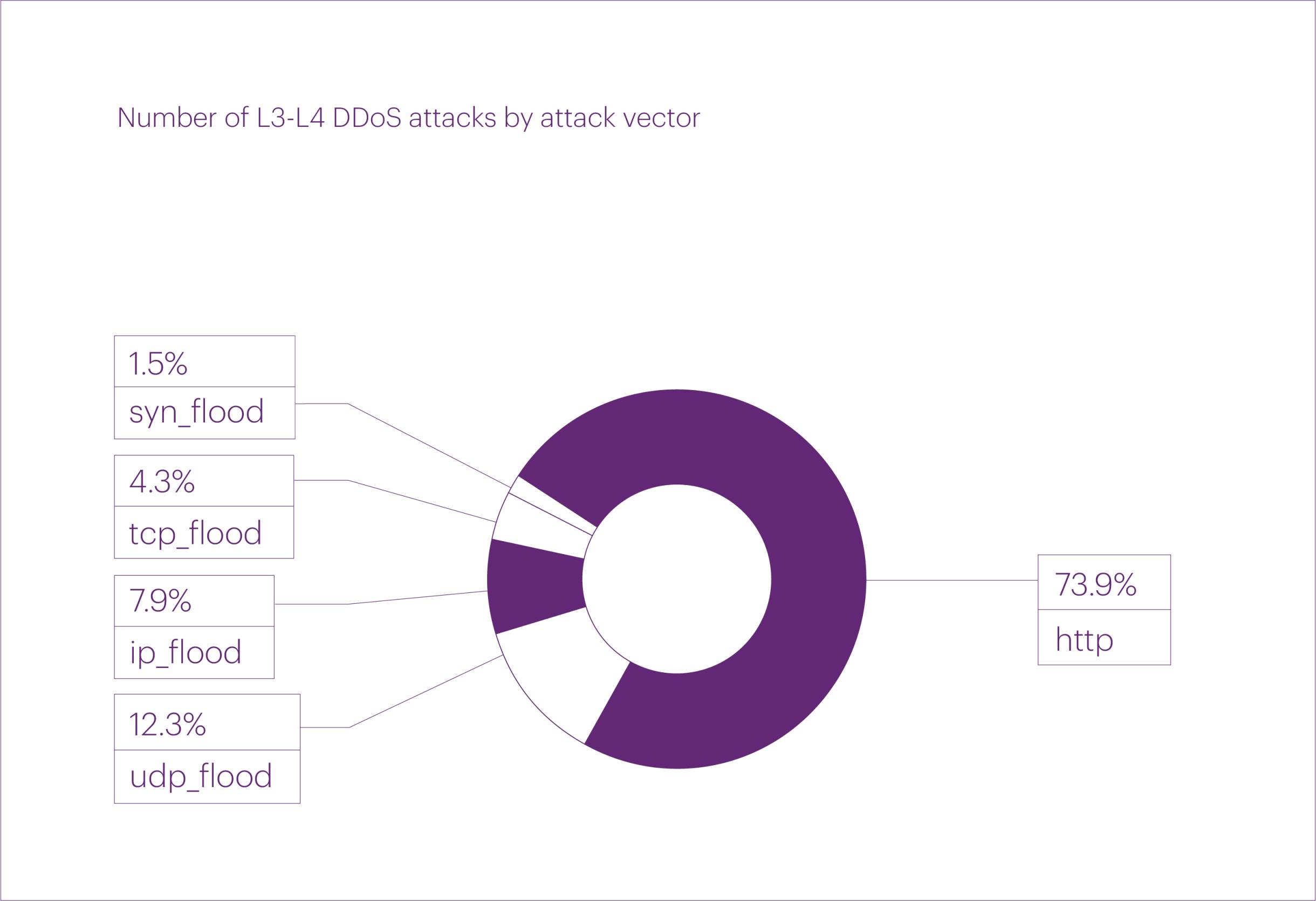
Under the new analysis methodology, multi-vector attacks accounted for 7.5% of all incidents in Q3 2025. About half of them (3.8% of all incidents) combined L3-L4 DDoS with L7 DDoS.
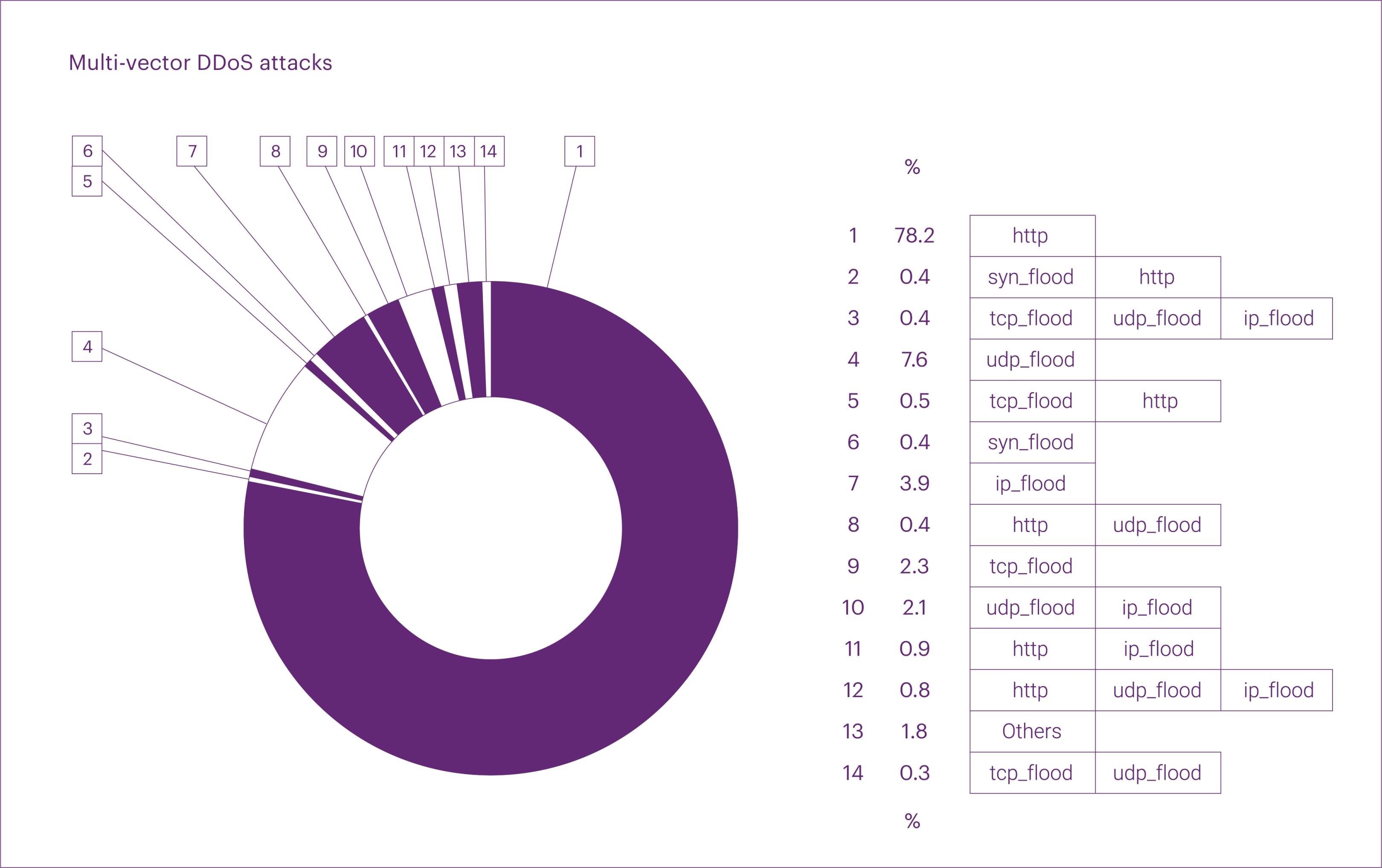
The most common class of L7 DDoS attacks in Q3 was Request Rate Patterns (37.9%), characterized by request frequencies that differ from the expected behavior of legitimate users. The second most common was the multi-class category Multiple Matched Criteria (17.2%), followed by Rotating Client Secondary Attributes (16.0%) — attacks involving unusual sets of request headers.
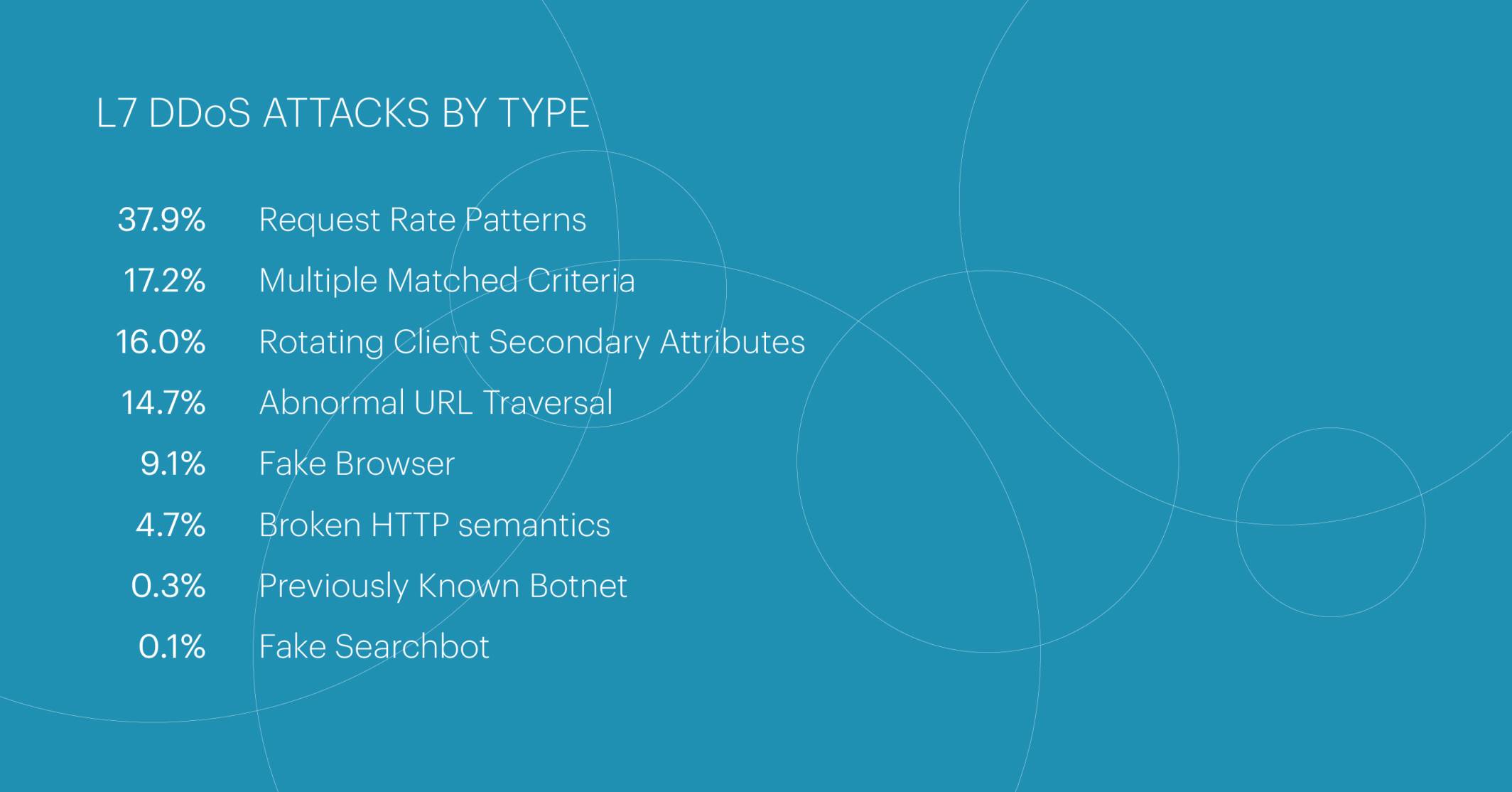
The longest DDoS attack in Q3 2025 lasted more than nine days (225.9 hours). The second-longest was also notable, lasting 119.2 hours — nearly five days. Finally, the third-longest attack in Q3 was relatively short, lasting less than a day — only 17.7 hours.
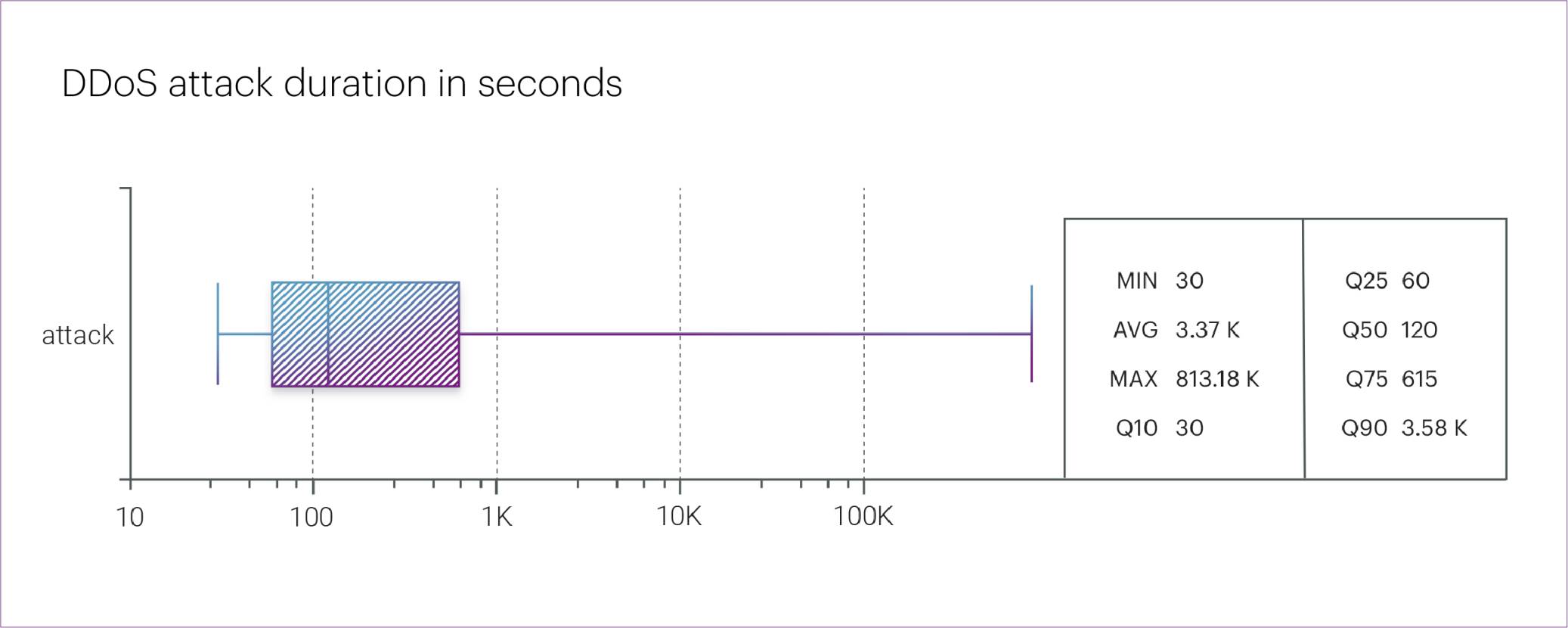
The average attack duration in Q3 was 3,370 seconds (about 56 minutes), while the median duration was only 2 minutes.
In Q3 2025, DDoS attacks most frequently targeted the FinTech (26.1%), E-commerce (22.0%), Media (15.8%), and Information and communication technology (14.5%) segments. Together, these four accounted for 78.3% of all attacks recorded during the reporting period.
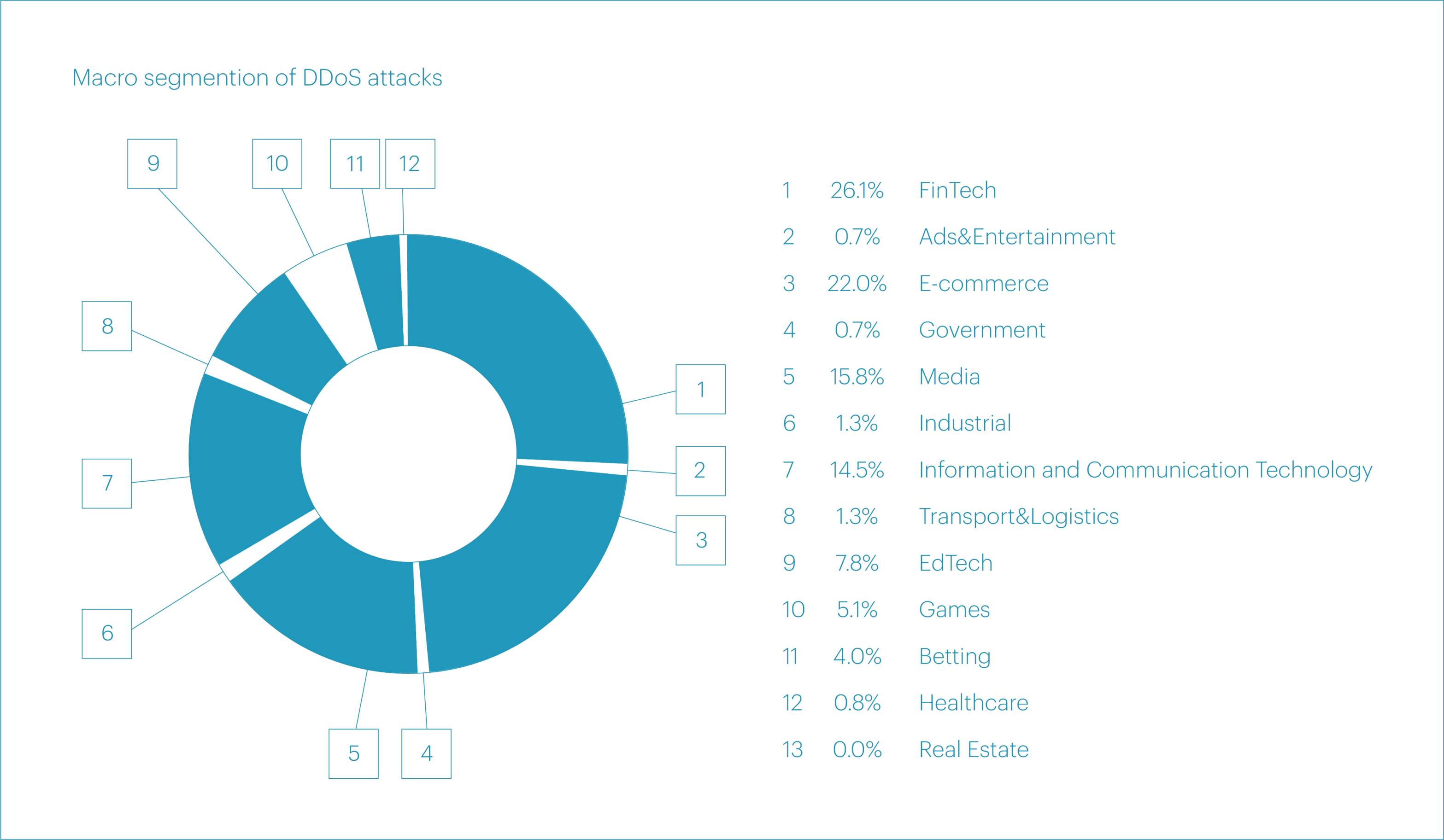
Looking at a more detailed breakdown, the largest number of DDoS attacks in Q3 targeted the following microsegments: Media, TV, radio, and bloggers (14.1%), Payment systems (13.9%), Food retail (13.0%), Digital education (7.2%), and Hosting platforms (6.6%). Combined, these five microsegments represented more than half (54.8%) of all attacks.
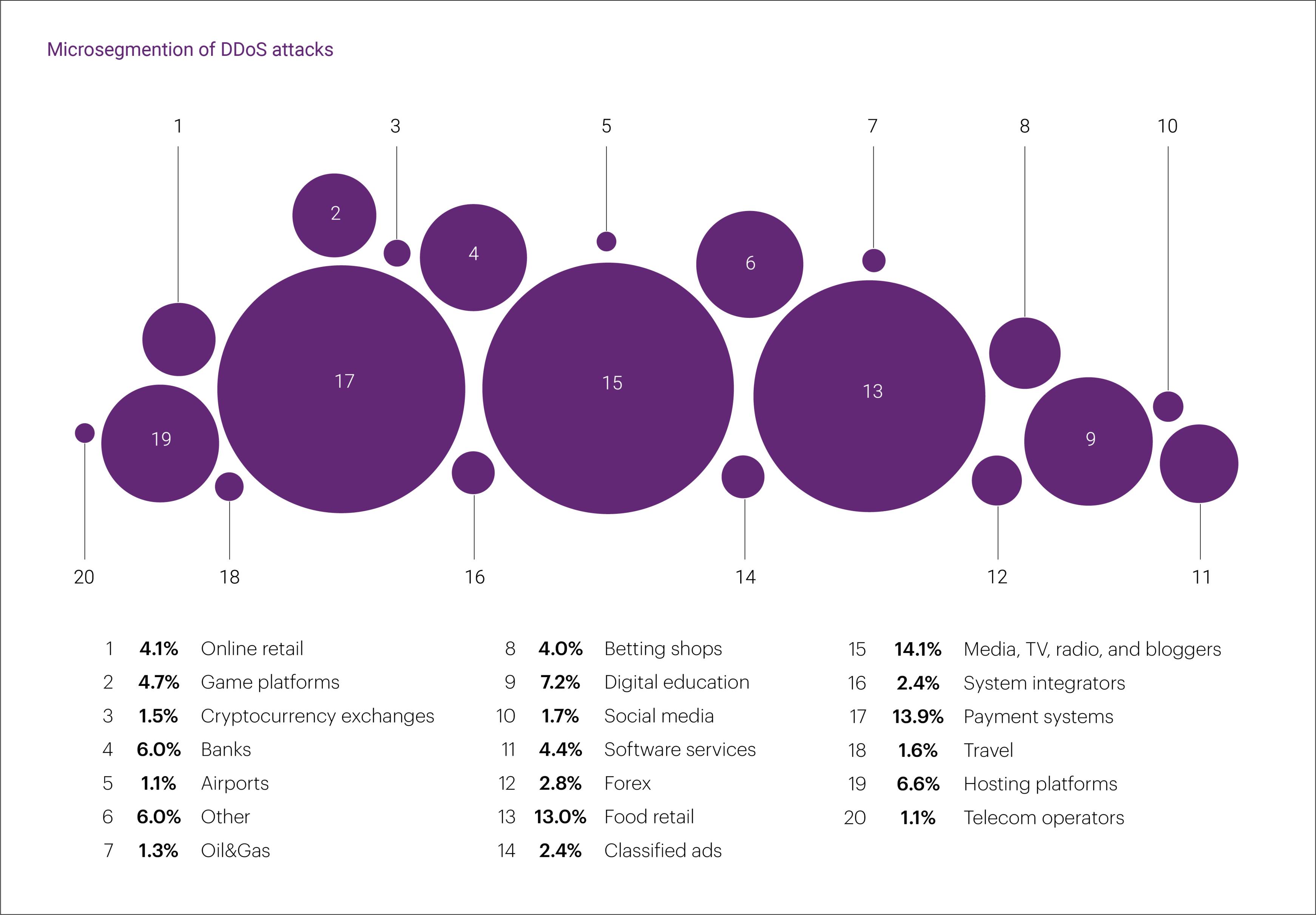
The most intensive L3-L4 DDoS attack of Q3 2025 occurred on August 27. It targeted an organization in the Online retail segment and lasted only a few minutes. Despite its short duration, the attack reached an exceptional peak of 1.15 Tbps — slightly exceeding the previous year’s record of 1.14 Tbps.
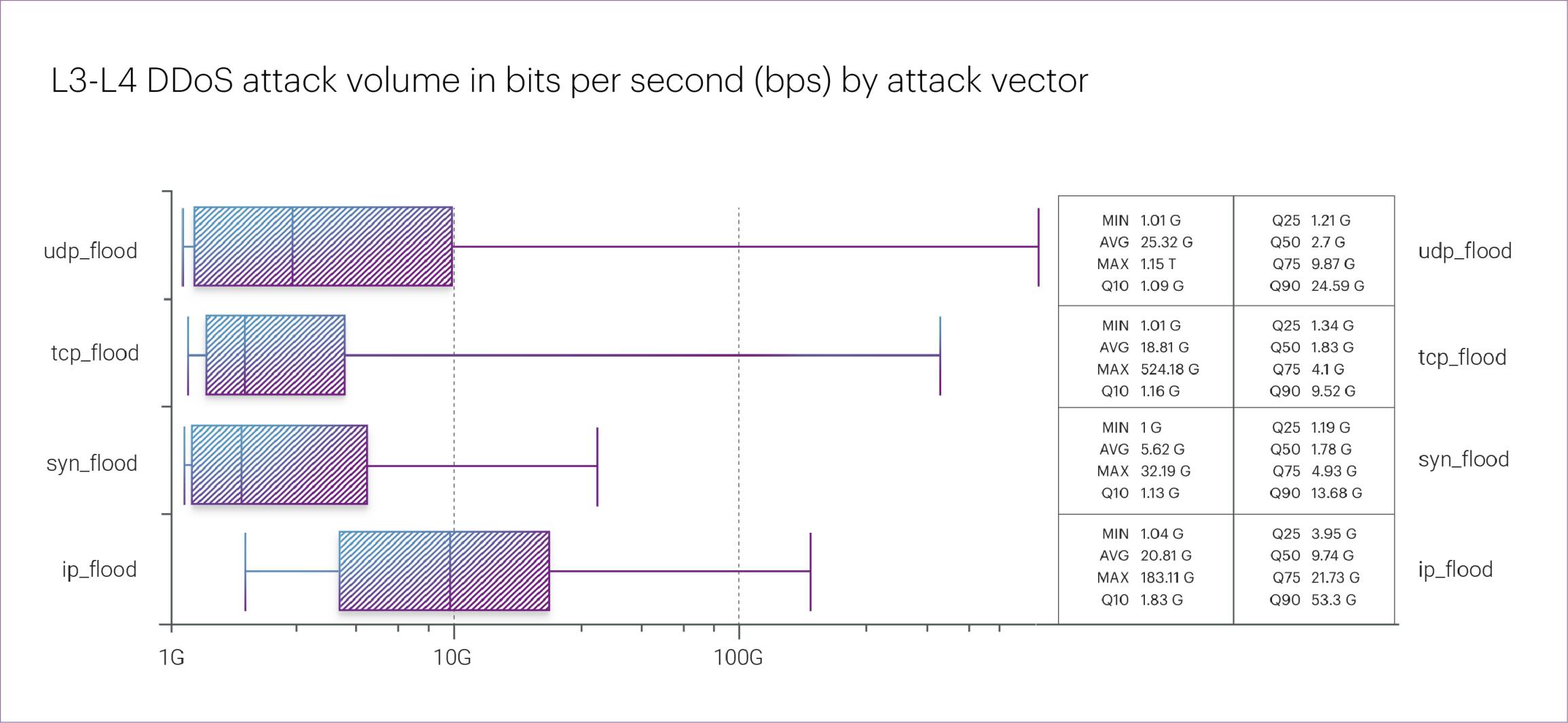
The same attack on Online retail also ranked highest by maximum packet rate, reaching 174.7 Mpps at its peak.
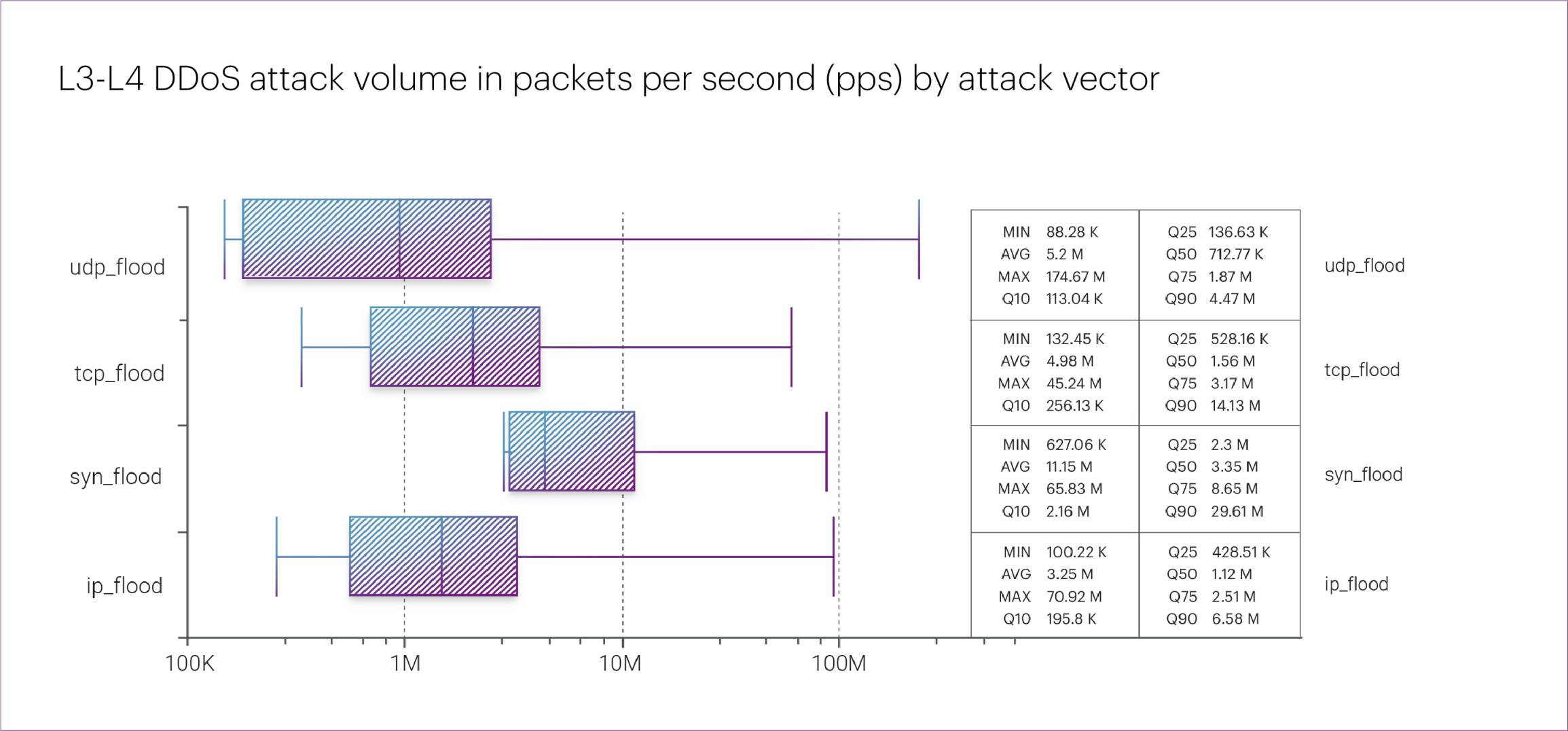
The top five microsegments that experienced the most intensive L3-L4 DDoS attacks in Q3 2025 were Online retail (1.15 Tbps), Media, TV, radio, and bloggers (524 Gbps), Gaming platforms (460 Gbps), Betting shops (240 Gbps), and Banks (177 Gbps).
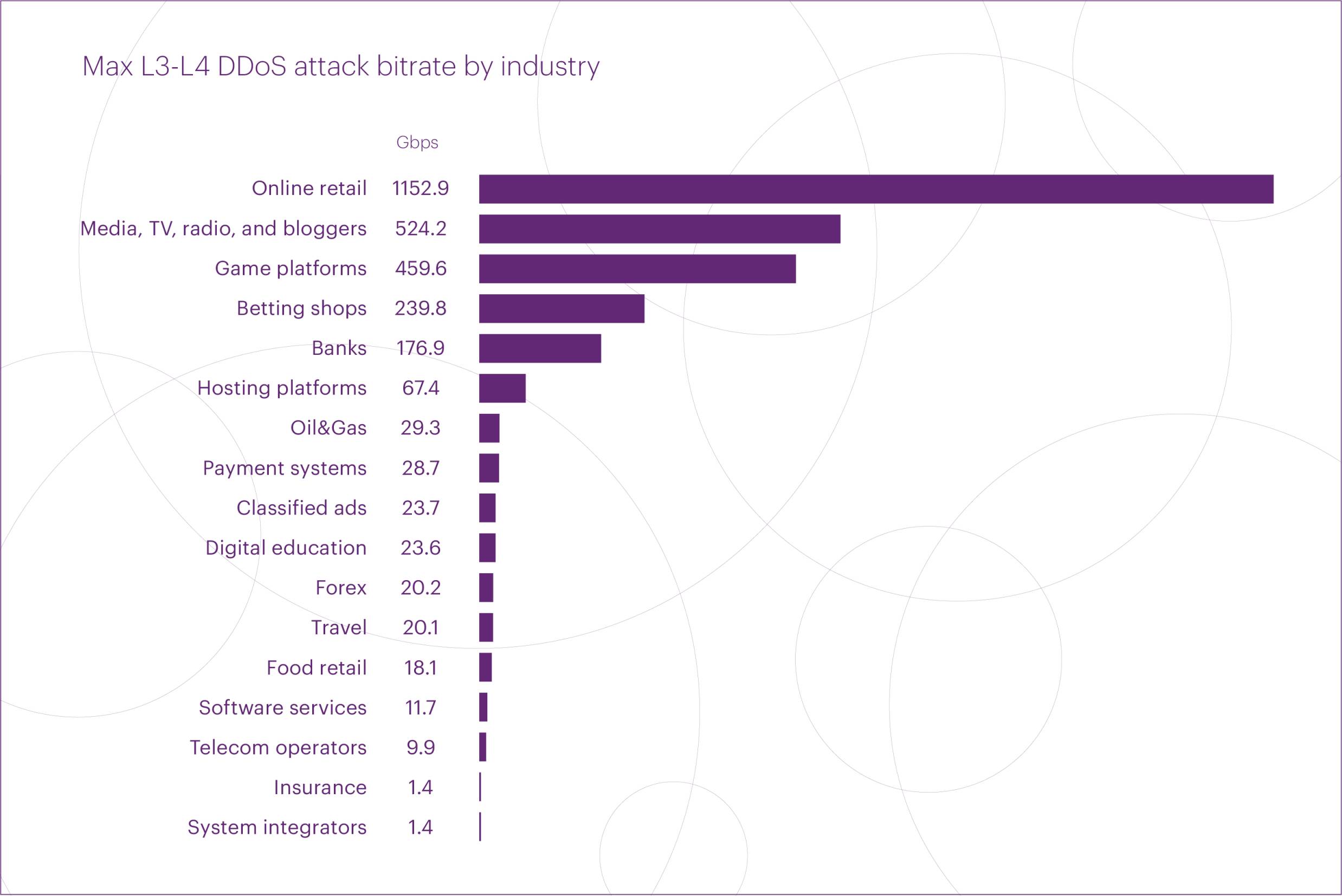
The ranking by peak packet rate looked very similar: Online retail (174.7 Mpps), Media, TV, radio, and bloggers (70.9 Mpps), Hosting platforms (65.8 Mpps), Betting shops (55.5 Mpps), and Gaming platforms (42.4 Mpps).
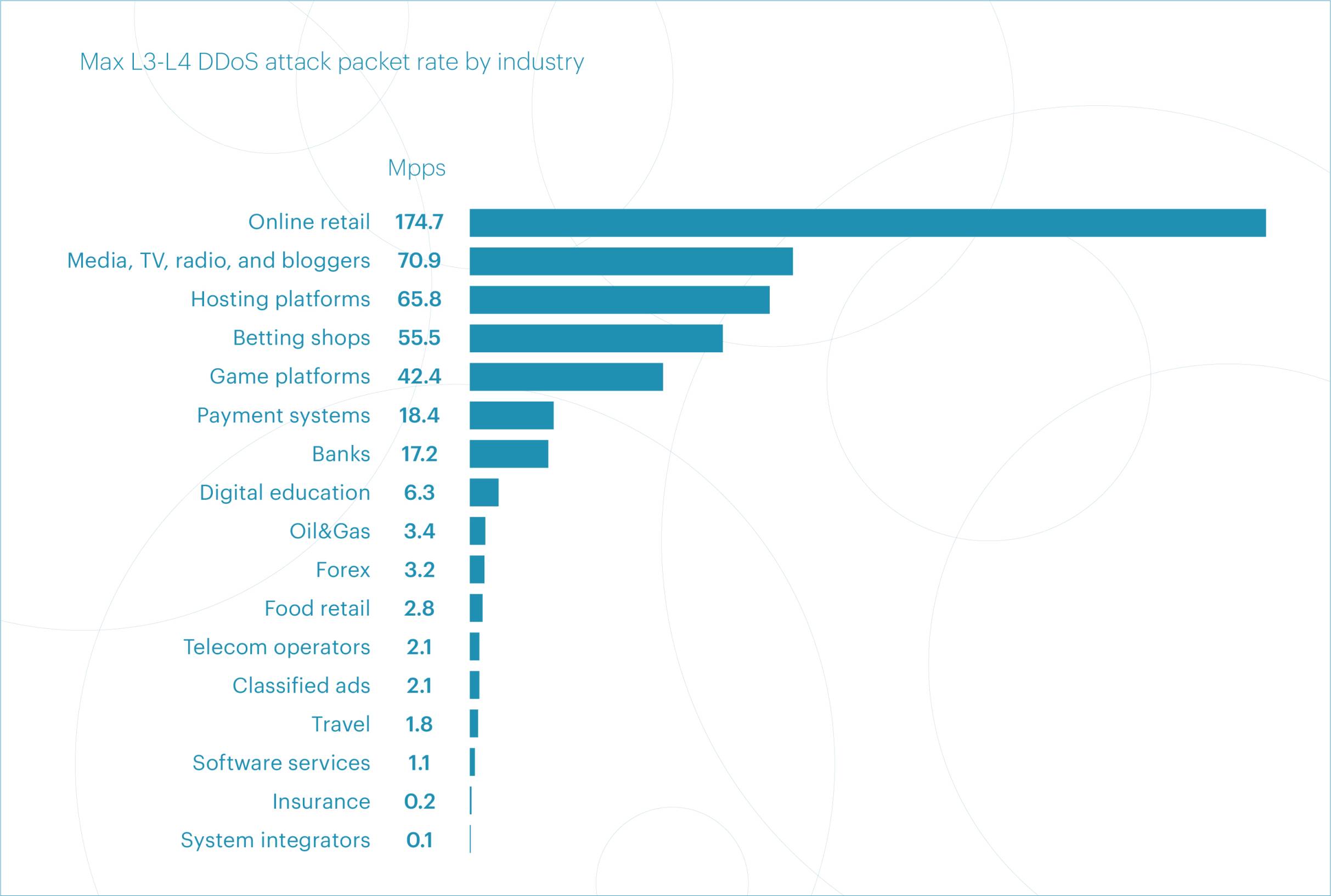
We continue to track a massive DDoS botnet that we first detected in Q1 2025. During its initial attack on March 26, 2025, we blocked 1.33 million IP addresses — primarily from Brazil (51.1%), followed by Argentina (6.1%), Russia (4.6%), Iraq (3.2%), and Mexico (2.4%).
In Q2, on May 16, 2025, we recorded another attack carried out by the same botnet, during which we blocked around 4.6 million IP addresses. By that time, the botnet’s geography had changed noticeably: Brazil’s share dropped from 51% to 29.7%; the share of devices from the United States (12.1%), Vietnam (7.9%), and India (2.9%) increased sharply; and Argentina (2.8%) ranked only fifth.
In Q3, on September 1, 2025, we observed another large-scale attack from the same DDoS botnet. During mitigation, we blocked 5.76 million IP addresses — meaning the botnet’s size more than quadrupled in less than six months.
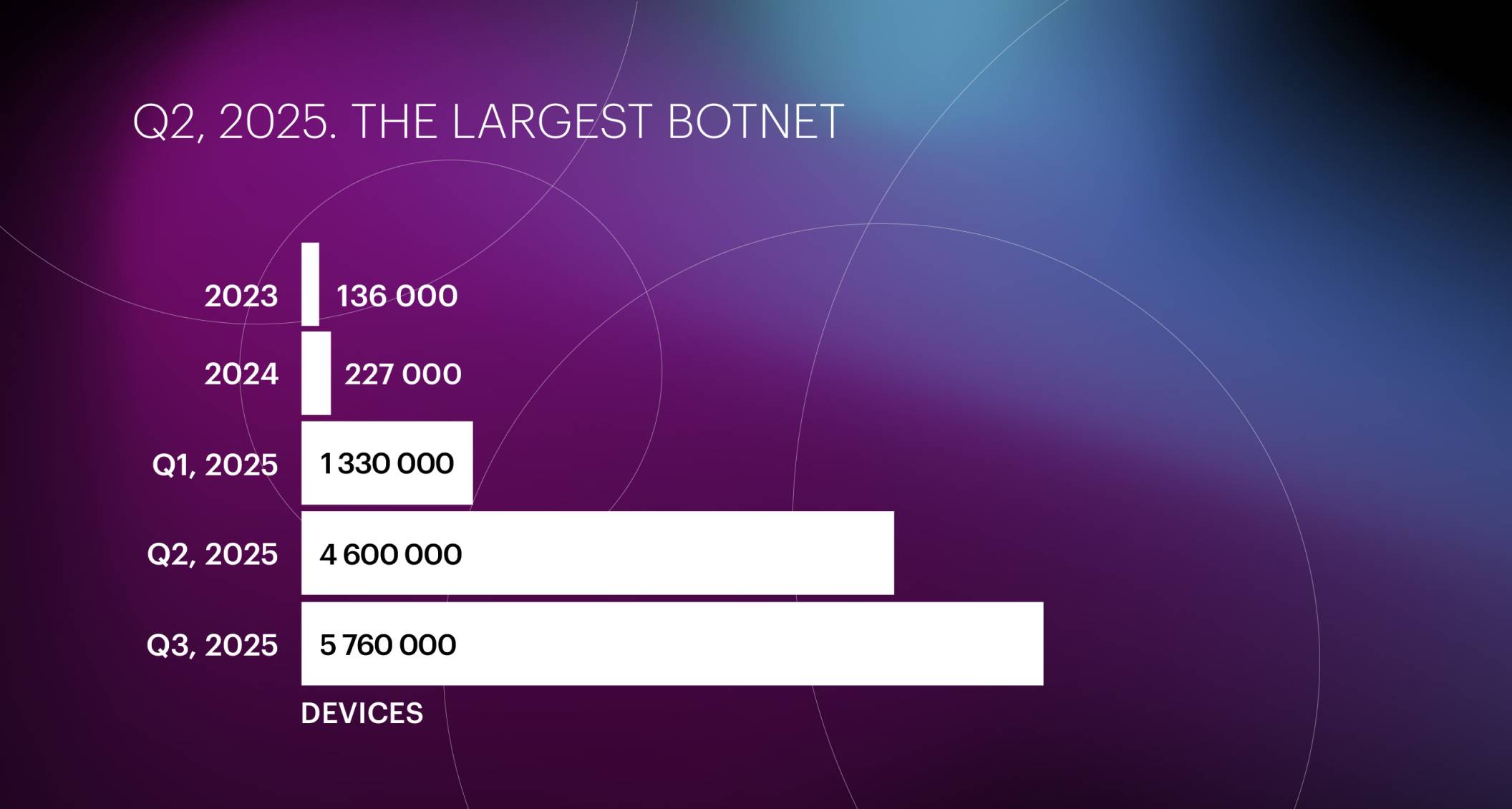
The new attack targeted an organization in the Government resources segment. It lasted about two hours and unfolded in two waves: during the first stage, the attackers employed around 2.8 million IP addresses, and roughly an hour later, they added another 3 million.
The geographic distribution of IP addresses used by this DDoS botnet continues to shift. Although Brazil still ranks first, its share has dropped to 24.5% of all blocked IP addresses. The rest of the top five now includes Vietnam (11.5%), the United States (11.2%), India (7.1%), and Argentina (2.8%).
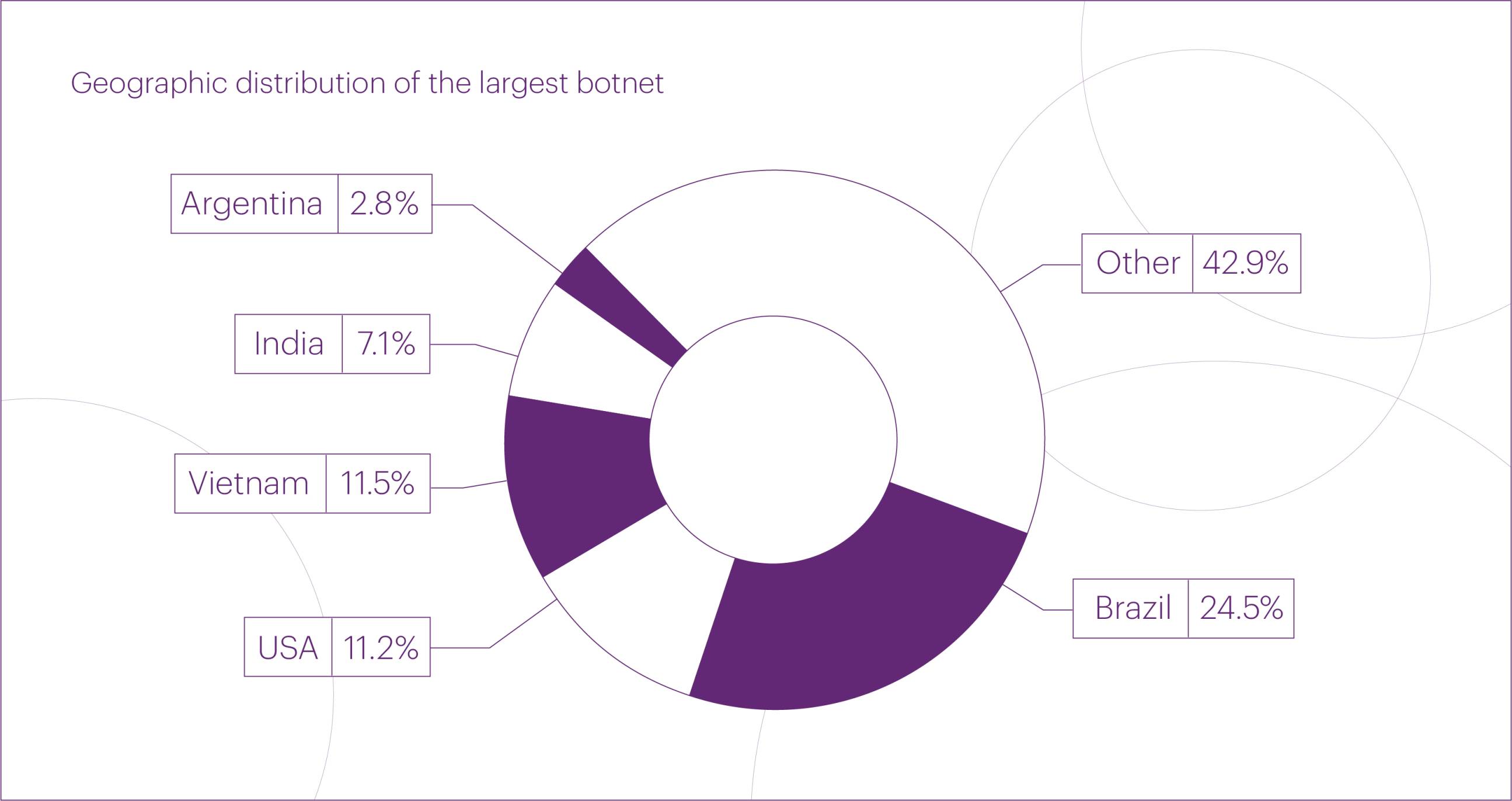
Vietnam (+83%) and India (+202%) showed the most impressive growth among the top five sources of malicious traffic compared to the previous attack by this botnet.
At the same time, the share of other countries increased from 32.6% in March to 42.9% in September, demonstrating the botnet operators’ active efforts to diversify its geographic footprint. This diversification makes simple geoblocking ineffective against attacks from this botnet, as its operators can switch to IP address ranges from virtually any country at any time.
In Q3 2025, for the first time in several years, there was a change in the ranking of countries most frequently serving as sources of application-layer DDoS attacks. Brazil took the lead with 19%, pushing Russia (18.4%) to second place and the United States (10.3%) to third. Notably, Brazil’s share has been steadily and rapidly increasing throughout the past year.
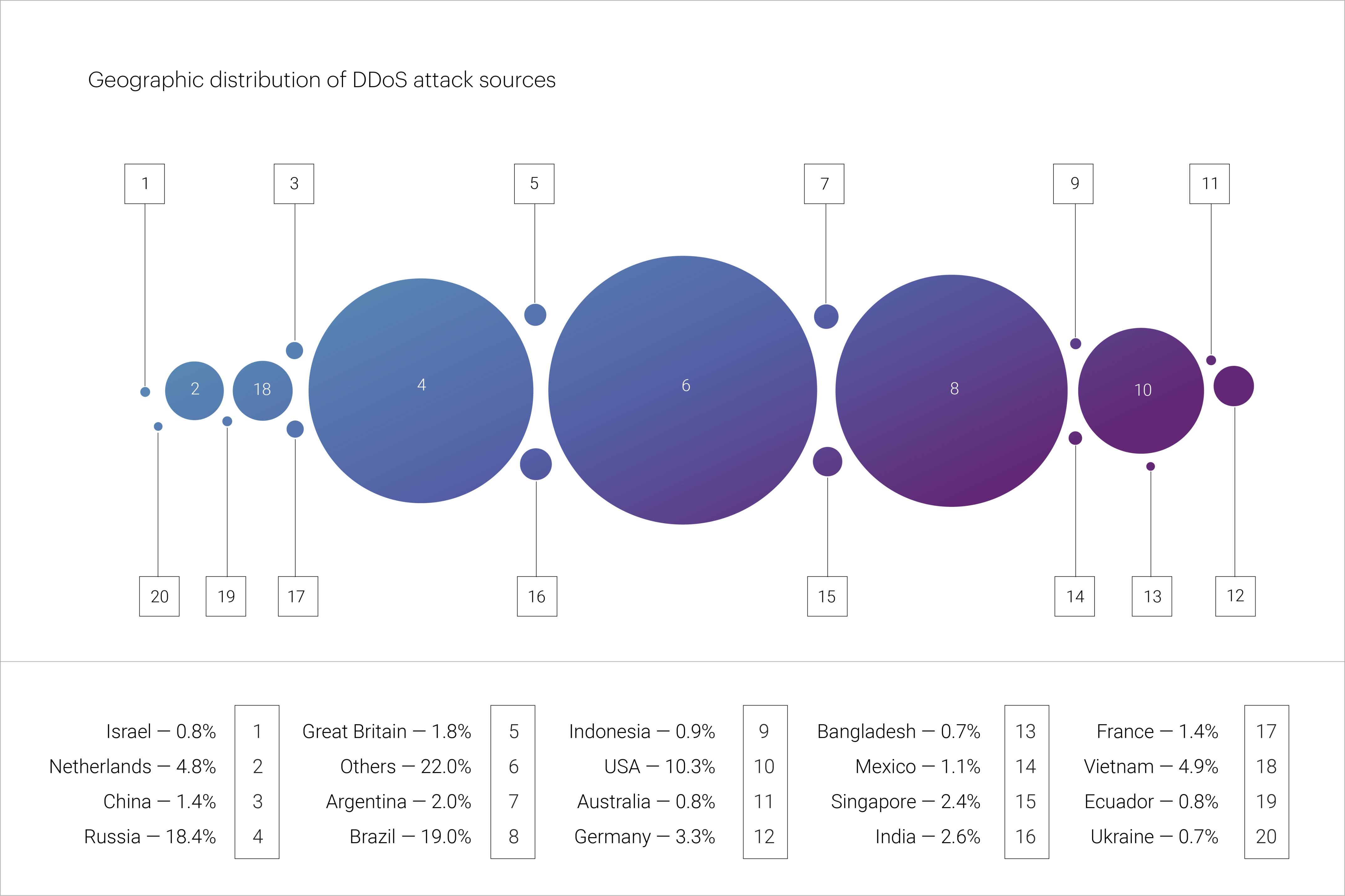
The top ten sources of L7 DDoS attacks also included Vietnam (4.9%), the Netherlands (4.8%), Germany (3.3%), India (2.6%), Singapore (2.4%), Argentina (2.0%), and the United Kingdom (1.8%). Together, these ten countries accounted for 69.5% of all IP addresses blocked during application-layer attack mitigation in Q3.
Note that Vietnam’s share has shown steady growth — rising from 15th place in the ranking a year ago to fourth place in Q3 2025.
We attribute the emergence of massive DDoS botnets and the growing share of developing countries among application-layer attack sources to two main trends.
On the one hand, there is outpacing digitalization in developing countries — a rapid increase in the number of devices connected to high-speed Internet, combined with low cybersecurity awareness and a high number of vulnerabilities.
On the other hand, there is the widespread availability of AI-powered tools actively used by attackers. Artificial intelligence enables them to automate the search for and exploitation of vulnerable devices, greatly accelerating the creation and expansion of botnets.
To avoid confusion, it’s important to clarify that “bad bots” refer to automated systems that attempt to interact with websites while pretending to be legitimate users. Unlike destructive DDoS bots, bad bots do not aim to disrupt a site’s operation. Their goals typically include data scraping, artificially inflating metrics, brute-forcing accounts, and other unwanted activities.
After a 31% surge in bad bot traffic in Q2 2025, Q3 saw an equally sharp decline of 37%, despite a noticeable increase in the number of resources protected by Qrator.AntiBot.
As we noted in the previous report, the growth observed in Q2 was almost entirely driven by a single, exceptionally large-scale attack that lasted more than a month. Once it ended in May, bad bot traffic volumes targeting protected resources dropped significantly.
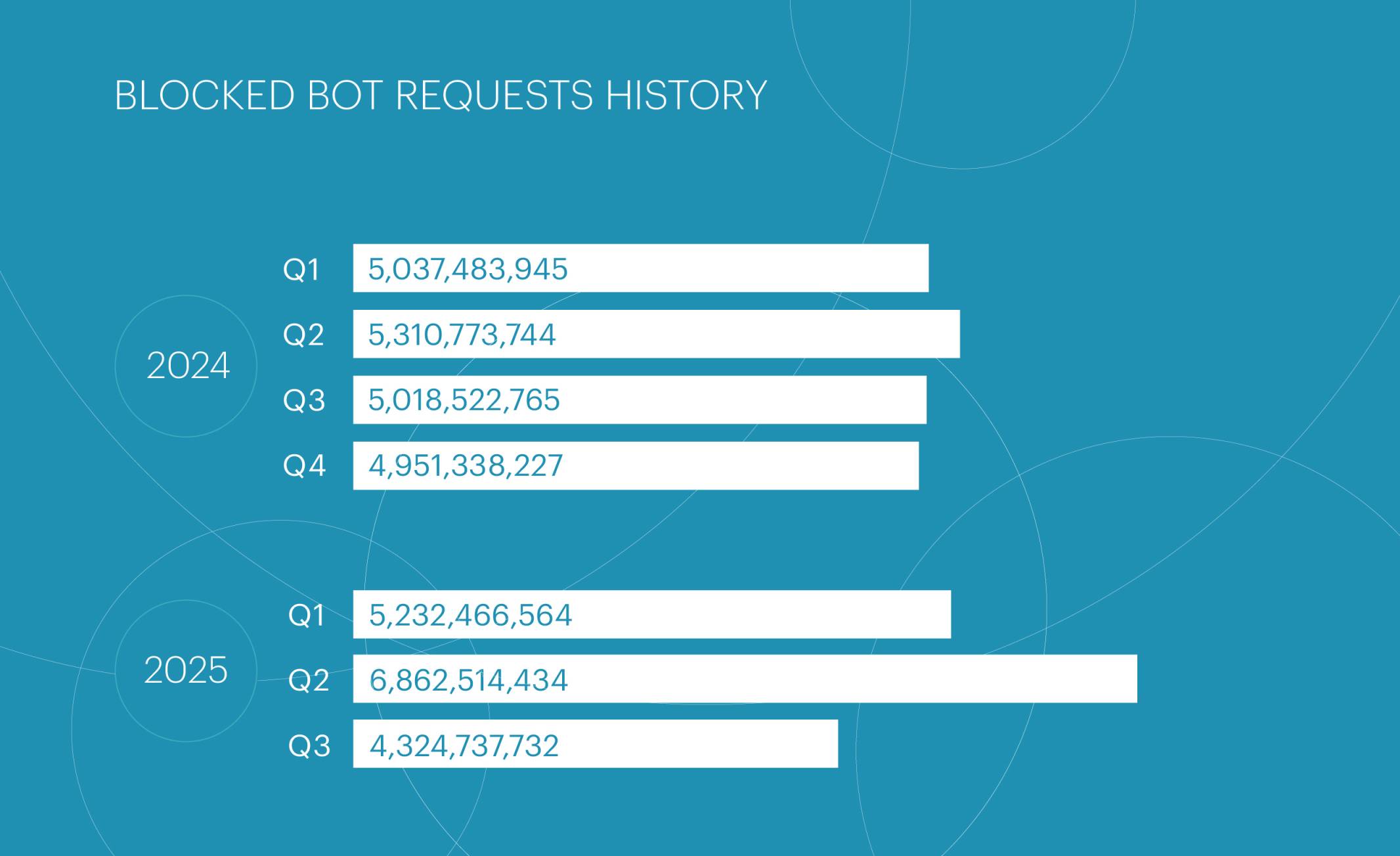
The quiet period largely covered the summer months, after which bad bot activity began to pick up again in September.
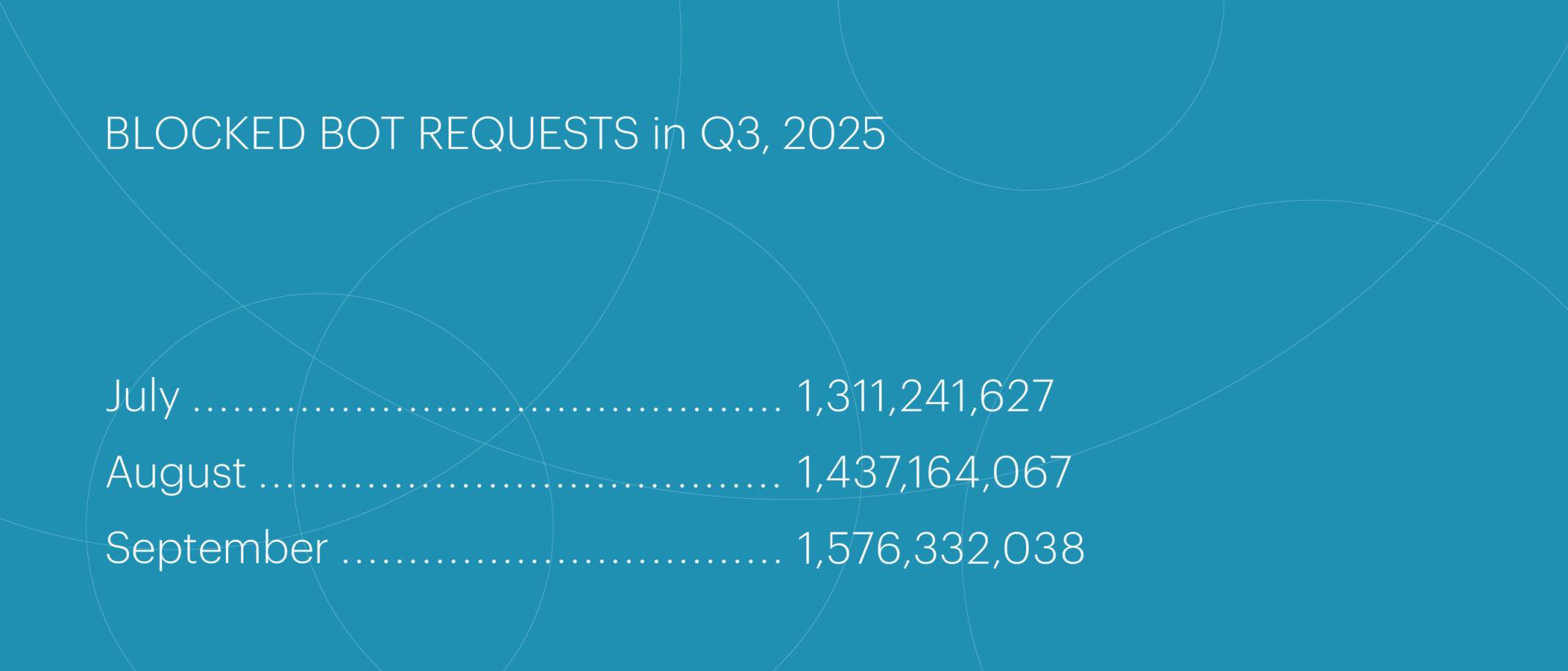
In Q3 2025, bad bot attacks primarily targeted the E-commerce (42.79%) and Betting (21.71%) segments, which have traditionally led this ranking. The Healthcare segment unexpectedly ranked third this quarter (17.52%), mainly due to a significant volume of traffic directed at a single resource.
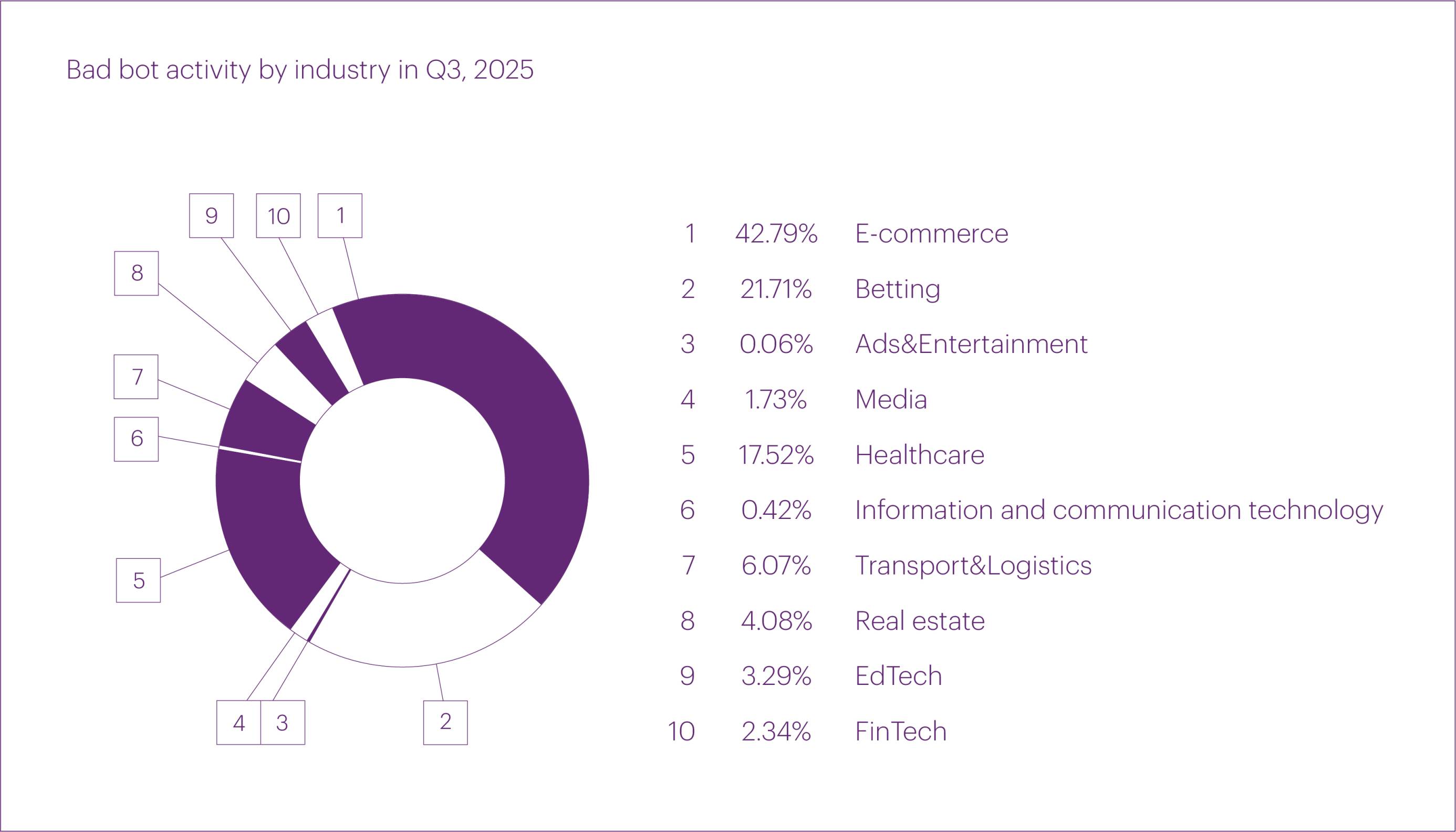
Since last quarter, we have been analyzing what we call the bot index: the share of bot traffic within the total traffic to protected resources. In Q3 2025, this indicator dropped significantly compared to Q2, from 2.34% to 1.36%.
The bot index continues to vary across industries. The three segments most affected by bot traffic in Q3 were Digital education (7.88%), Healthcare (4.38%), and Betting (3.74%).
It should be noted that Qrator.AntiBot allows customers to configure on which pages and domains the protection is active. Therefore, a significant portion of bot traffic may not be reflected in this statistic.
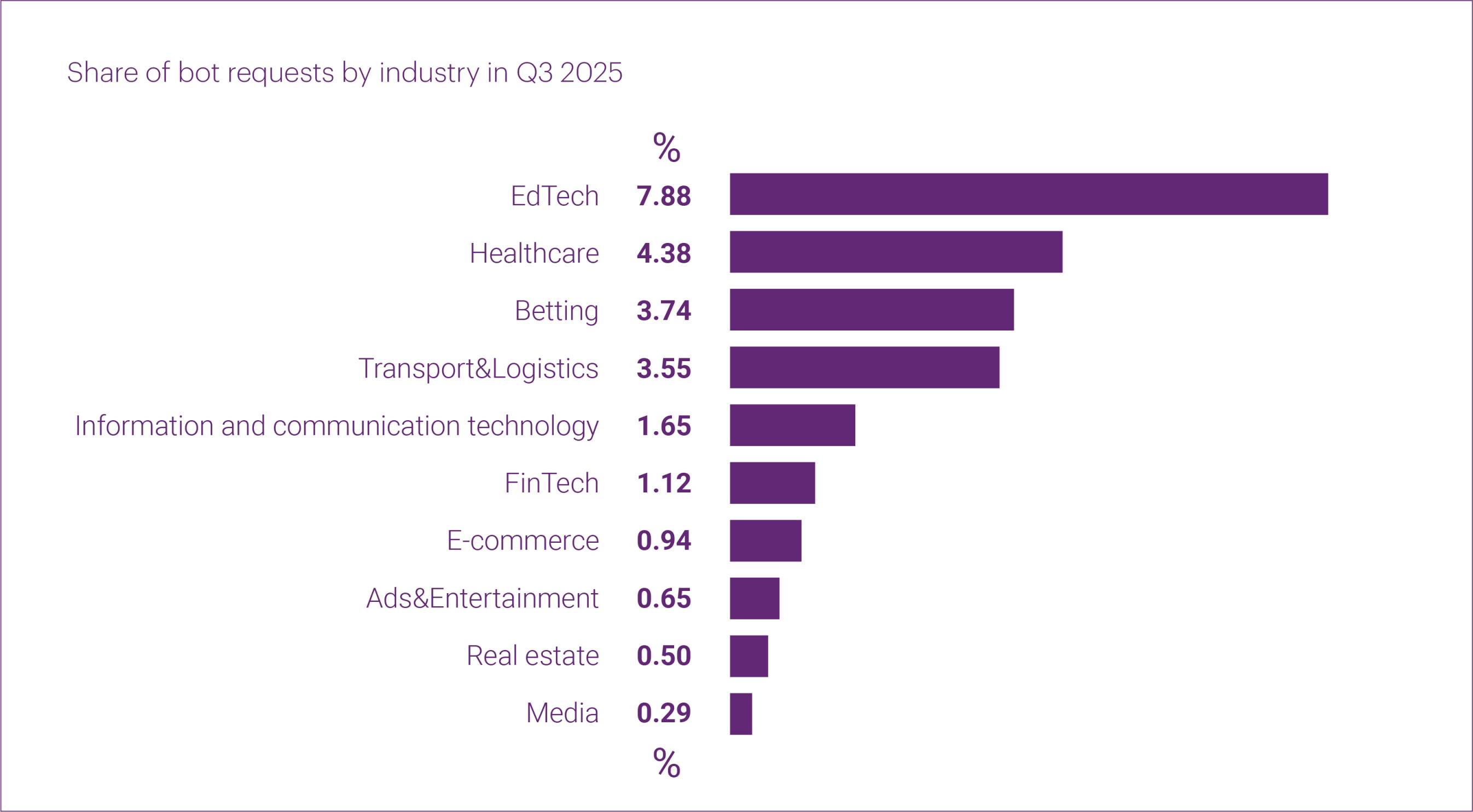
Since last quarter, we have refined our bot categorization, now distinguishing four types instead of three:
As a result, the previously used category “browser bots” has been divided into two separate types — puppeteer bots and smart bots.
In Q3 2025, compared to Q2, the share of simple bots (59.18% → 58.15%) and API bots (38.01% → 36.91%) slightly decreased, while the share of puppeteer bots (2.58% → 4.49%) and smart bots (0.23% → 0.44%) nearly doubled.
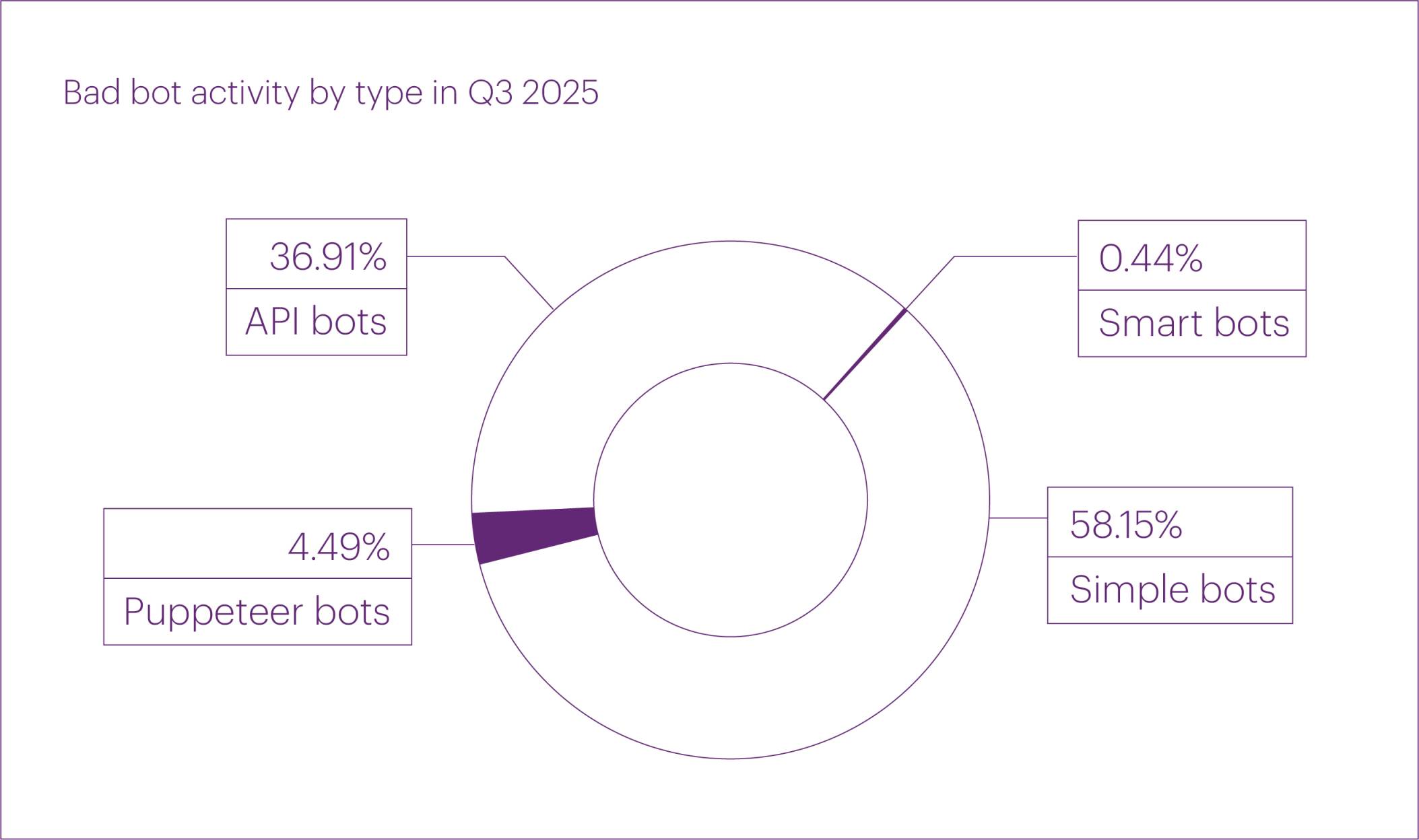
The longest bot attack in Q3 occurred on September 4 and targeted an organization in the E-commerce segment. The attack lasted for 14 hours and 33 minutes, during which Qrator.AntiBot blocked a total of 9,276,340 bot requests.
At first glance, this duration may seem modest. However, it represents only a single episode. In reality, bad bot attacks targeting this organization have been blocked continuously since the protection was enabled. For instance, over the past six months, bot activity across this organization’s resources has been as follows:
The most intensive attack of Q3 targeted another organization in the E-commerce segment. At its peak, the attack reached 210,725 malicious requests per second — nearly half the record set in the previous quarter (441,147 requests).
During this incident, the attackers first attempted to disrupt the resource using a TCP flood that peaked at 2.63 Gbps. When this L3-L4 DDoS proved ineffective, they switched to junk application-layer requests, which also failed to achieve their goal.
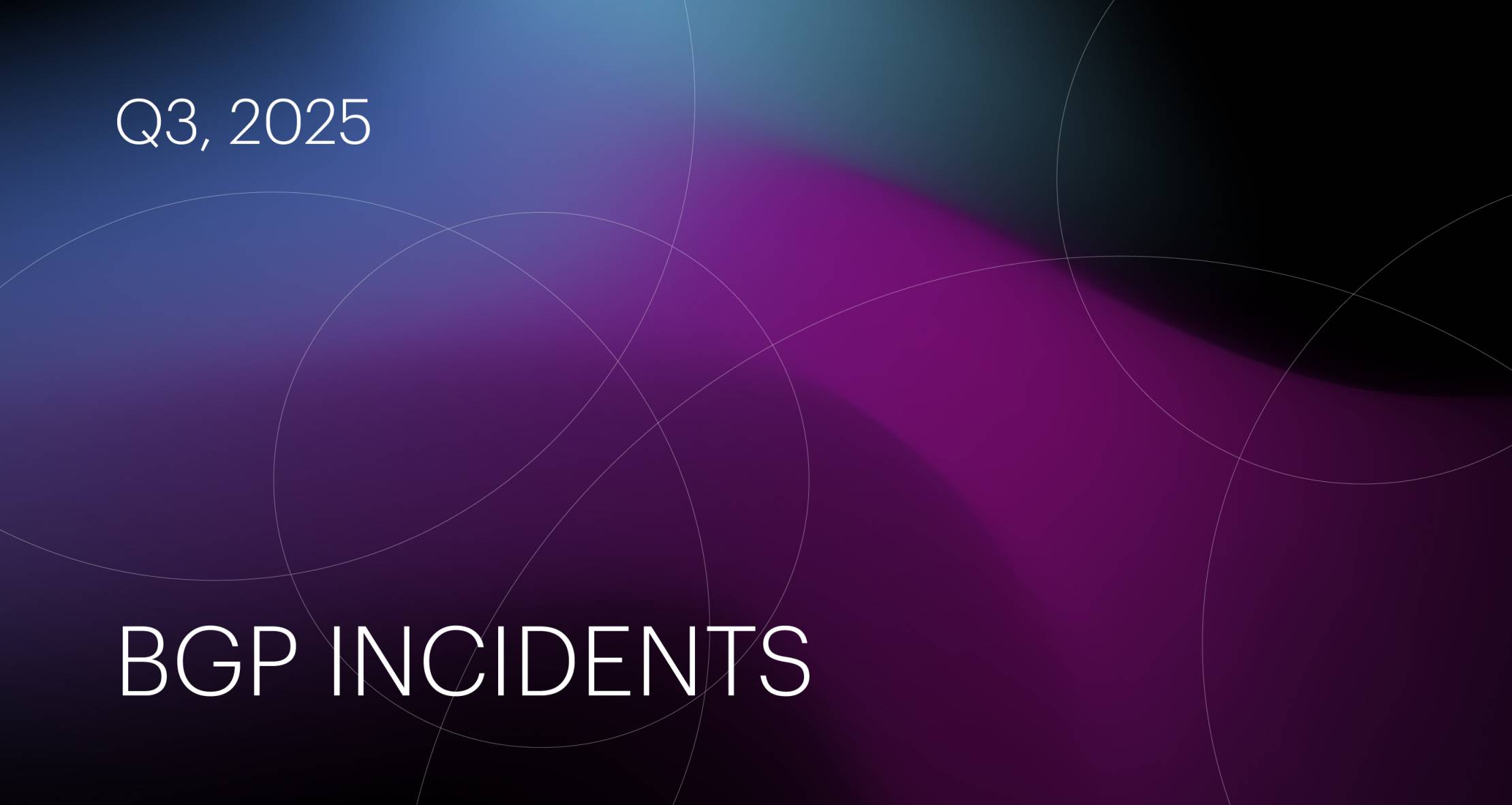
The number of unique autonomous systems (ASes) responsible for route leaks in Q3 2025 remained roughly the same as in the previous several quarters. However, the number of unique ASes involved in BGP hijacks was slightly lower than in prior periods. This decrease in activity was primarily observed in July, while in August and September, the figures returned to typical levels.
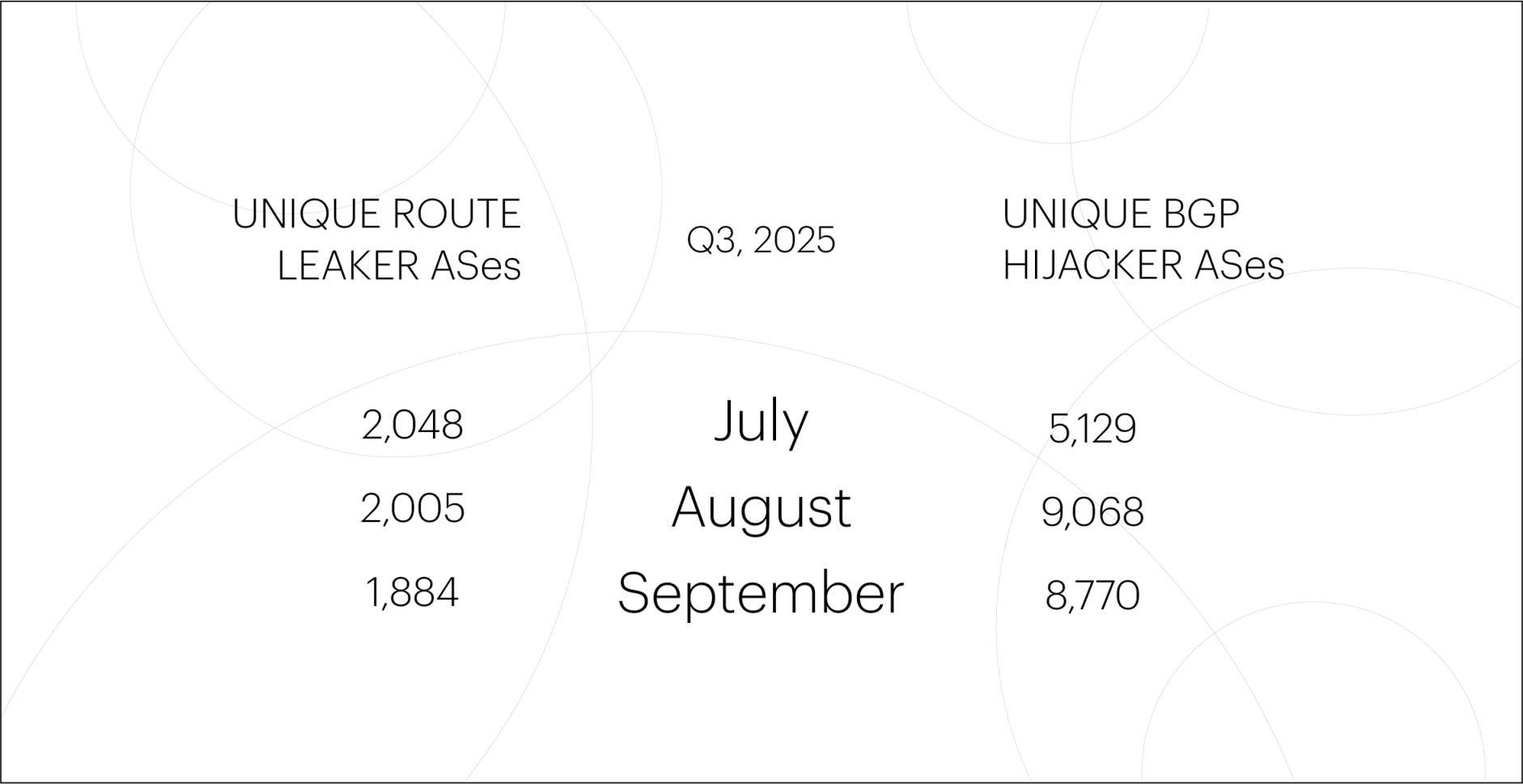
Note: The Qrator.Radar team identifies global BGP incidents using a set of threshold criteria. These include the number of affected prefixes and autonomous systems, as well as the extent of the anomaly’s propagation across routing tables.
After the sharp surge in global BGP incidents reported in Q2 2025, Q3 was significantly calmer. During this period, we recorded only five global incidents — four route leaks and a single BGP hijack.
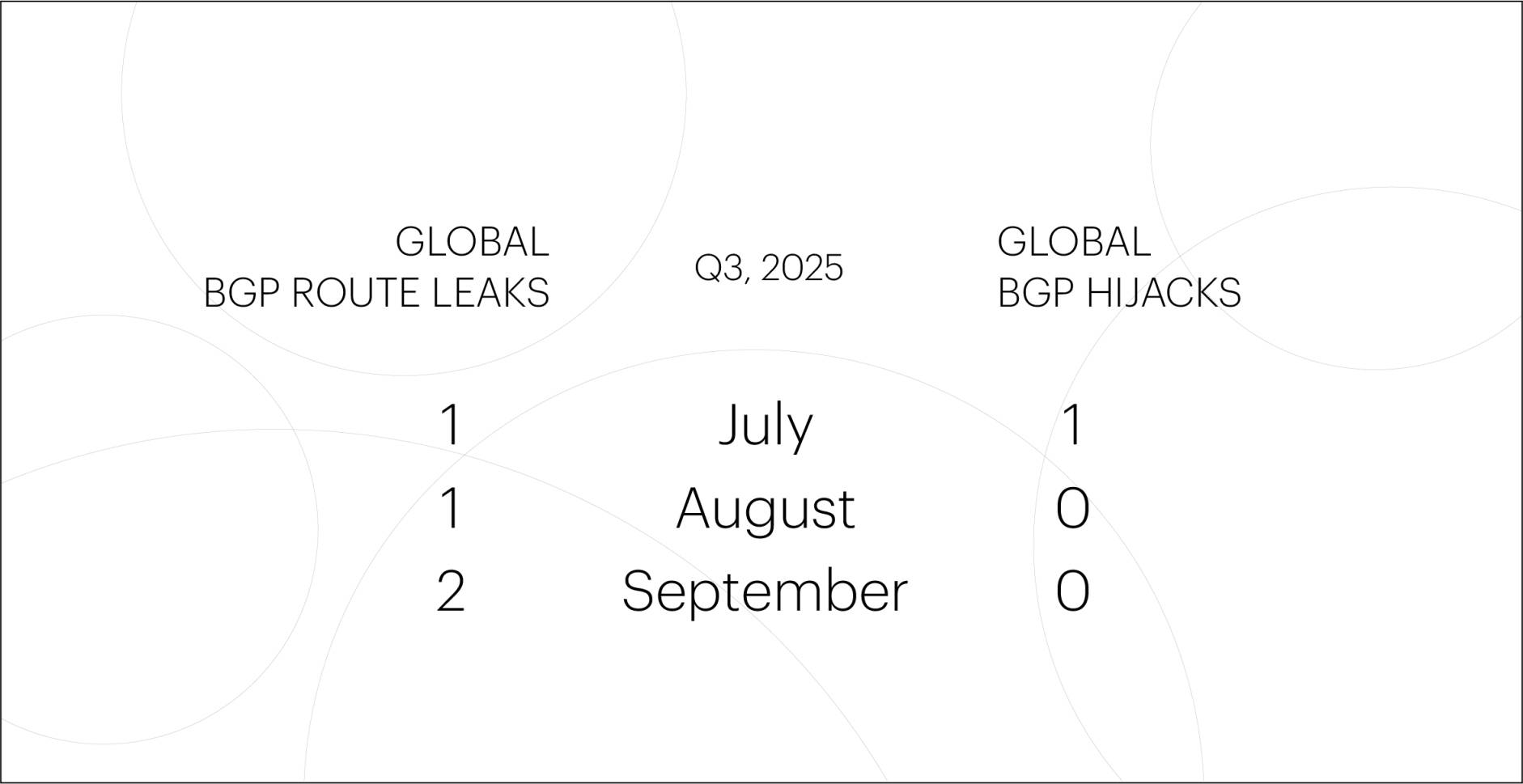
For comparison, in the previous quarter, we identified 14 global incidents — 10 route leaks and 4 BGP hijacks.


Share your experience and expectations regarding DDoS protection. Your answers will help us tailor solutions to meet your cybersecurity needs.
Tell us about your company’s infrastructure and critical systems. This will help us understand the scope of protection you require.
Help us learn about how decisions are made in your company. This information will guide us in offering the most relevant solutions.
Let us know what drives your choices when it comes to DDoS protection. Your input will help us focus on what matters most to you.